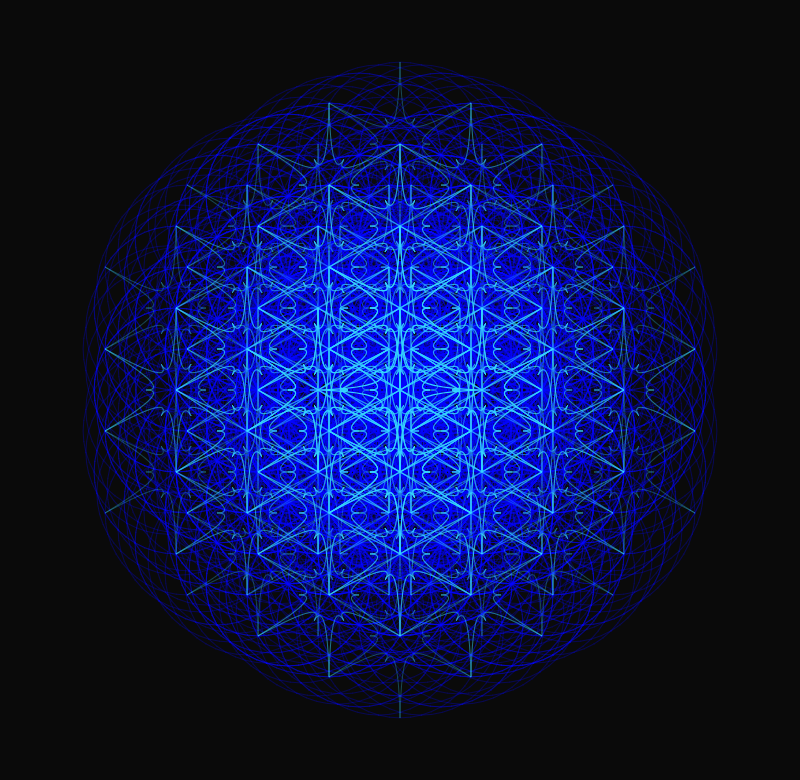ASTRAL DIVER 5: The Vectors of Vision in Hypnagogia
An image generated of a diver in AI, enhanced with vector lines from OmniGeometry.
In 2019 I set out to find the means through software to render what I see during hypnagogic visions. Software like Adobe Illustrator or Pixelmator allowed for rudimentary renders. I came upon OmniGeometry and understood I had found software that could more closely approximate the geometrical lattices resplendent in hypnagogia. The key question this entry proposes is: why do hypnagogic geometries look like digital vector art?
Art by Giovanni ©2023 Created with OmniGeomtery software.
While hypnagogia has not been the subject of intensive investigation, those that have investigated it tend to prioritize what we see when we are awake. The visual experience of the waking mind is assumed to feed what we see when we are asleep. These studies focus on the fact that we will see our inner vision replay imagery from videos, especially animated, graphic art. In the case of a Harvard study, a geometry-based video game was used by subjects who then reported they saw cubic imagery like that of the game Tetris as they were falling asleep. Let’s instead prioritize the fundamental properties of hypnagogic visuals as vector-like, i.e., mathematical in nature. If we are going to treat time as having a historical direction, we can certainly attest that the visual neocortex came before computers. In this case, vector art, especially animated vector art or anything highly geometrically recursive, is reminiscent of our inner visual light-show. At all times I will prioritize what we see when we are in a hypnagogic or hypnapompic state.
It is true that highly reiterative and especially animated vector graphics do influence the visual cortex, and for those of those who make graphic art animations or generate them from creative coding, it is common to see our designs at the onset of sleep. However, hypnagogic geometric lattices likely influence our art. We find reiterations attractive and have historically used them to decorate our world. My goal in working with software is not to make something attractive but to generate the kinds of patterns I see in hypnagogia. We have a lot we can learn about how we visually encode our world in the neocortex, and how it relates to memory. We also have w new frontier, that of quantum electrodynamics as experienced directly by the neocortex during hypnagogia. Further, as I wonder where exactly I see the geometric lattices, we may discover that the visual neocortex is not storing these visuals locally at all. Possibly the neocortex is a tuner.
Synapses.
Where exactly are the geometric light patterns stored in brain tissue? EEG shows a lot of activity around the brain during hypnagogia, but as yet we have no mechanism to follow into the experience. We have only the experience. So we will follow the experience to see where it takes us. Let’s define what we see.
Basic honeycomb lattice.
Hypnagogic visuals are typically:
Geometric
Linear or Vector-like
Illuminated
In motion
Black background is typical
Flat
Layered flat or lattice-like
Constantly changing
May be figurative but typically remain flat or lattice-like
The answer to the question above, why do hypnagogic visuals look like vector art, is that we live in an omnisurfacial, holographic universe. Instead of focusing on hyperdimensions to explain the universe we can focus on the hypodimensional. By this I mean that all three or more dimensions are collapsed in a flat field. No matter how you slice the universe you will always end up with surface. This surface is two dimensional, superpositioned, and all other dimensions are collapsed or wireframed onto the omnifield. What we call the Fibonacci sequence is implicit to how this field self-organizes, namely through the hexagon or flat cube. The honeycomb is a three-dimensional extrapolation of this organization. Why the hexagon? An omnisurfacial flat universe has no “room.” Not only is the honeycomb the most space-saving means to generate space, it is what allows it. If you think this is a stretch, consider hydrogen. The very first element to issue out of the quantum is indeed hexagonal in crystal structure. Stay tuned…






